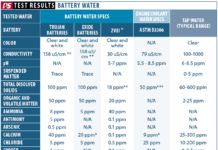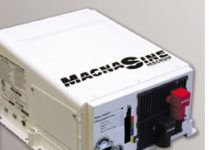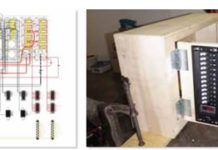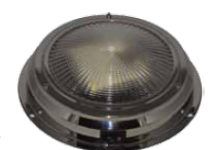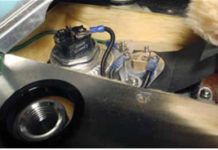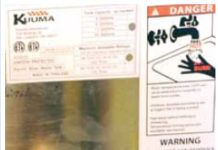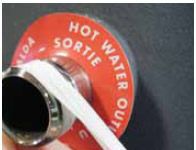AGM Batteries Test Update
In our recent test of absorbed glass mat (AGM) batteries, we cycled five different batteries through 30 deep cycles to 11.7 volts but only partially recharged them for one hour after each discharge cycle at a charge rate of 46 percent of battery amp-hour capacity. (See PS May 2015 online.) The object of the exercise was to demonstrate just how quickly sulfation, which is caused by keeping a battery in a partial state charge (PSOC), can reduce the capacity and eventually permanently ruin a good battery.
Watering Batteries
Our May 2015 report on absorbed glass mat (AGM) batteries got us thinking about wet cell-batteries. While it is easy to find distilled water suitable for topping off the battery electrolyte in the U.S., what happens when we are not near a reliable supply? Are there any substitutes? What should we avoid?
Whats the Voltage for Charging Gel Cells?
I just received the latest Waypoints e-letter about gel batteries, where you state they must be charged at no more than about 14.1 volts. We do not use gel batteries in our boat, but do in our camper van. As I understand, Trojan deep-cycle gels can be charged up to 14.4 volts and East Penn marine gel batteries up to 14.6 volts, so why are you recommending the lower voltage?
Heart Replacement
Sixteen years ago, contributing writers Joe and Lee Minick equipped their Mason 43, Southern Cross, with a Heart Interface Freedom 20 charger/inverter and a Link 2000R from Cruising Equipment, both made by companies based in Valley Forge, Penn. When both of these units were ruined during a knockdown (see PS, April 2013 online), they were forced to look for a replacement.
Electrical Panel Upgrade
Editors note: Designing, installing, and wiring a new main circuit panel on a full-fledged cruising boat is an extremely challenging refit project. The writer is a professional engineer who made sure that his installation met or exceeded American Boat and Yacht Council Standard E-11. Failure to adhere to the standard could result in fire, injury, or death. We offer the following article, which outlines the steps involved in constructing a custom panel, as a rough guide. In our opinion, such a project should not be carried out without the consultation of an ABYC-certified electrician.
Imtra, Hella Dome Lights Shine
In our previous cabin light reviews (PS, May 2010 and January 2009), the transition from incandescent lighting to fluorescent and finally to LED was favorably noted. Since then, the evolution has turned into a solid-state revolution, and LEDs bolstered by dimmers, touch switches, and watertight seals now own the show. And a clean-sweep conversion to LED cabin lighting can knock out the grotto-like ambiance that haunts many sailboat interiors. Often, its not a problem of having too few lights; its an energy shortfall revolving around too few amperes to spare. An LED makeover is also an opportunity to illuminate the lockers, engine room, and other cave-like confines that cause you to reach for a flashlight and wish for an extra hand to hold it. Not only is the timing right to tap into a new genre of energy-efficient lights, but the product range and pricing offer a gameplan for every budget.
Marine Water Heater Test
In the December issue PS evaluates four water heaters that are new or have been significantly updated since our last test in 1999. Water heaters are one of those silent heroes that rank high on the list of comforts on a boat. The test field included the Kuuma 11842, an 11-gallon tank; the stainless-steel Quick Nautique BX2012; Raritans 1706; and the 30-liter Compact from Sigmar Marine. Testers considered each heaters efficiency (using AC and engine-driven power), power consumption, construction quality, and ability to keep hot water hot.
Mix of Water, Amps, and Heat Calls for Caution
It is surprising to see equipment with no moving parts carry such an array of safety warnings. But any time water and higher-voltage AC electricity are mixed, there are details worth thinking about. The risk of shock can be lessened through a firm commitment to three-conductor wiring that follows the American Boat and Yacht Councils guidelines. This includes maintaining the continuity of the green grounding that links the boiler and metal housing to the boats ground. Strict adherence to high-quality crimp connectors, appropriate wire gauge, and care in keeping the neutral and hot wires consistent with the vessels and docks power supply are paramount.
Installing Water Heaters
The physical installation of a water heater may seem pretty straightforward, but the devil is indeed in the details. It starts prior to purchase with a search for adequate space thats relatively near the engine and vertically as low as possible. Next is bonding in a well-reinforced surface to mount the water heater onto. The empty tanks are relatively light, but if you add 45 to 88 pounds of water, you can see why a sound support base is important in a rough seaway.
Construction Quality Draws Testers Attention
Our testers began the evaluation with a close inspection of how each unit was assembled and what materials were used in their manufacture. The test field included stainless-steel, aluminum, and mild-steel boilers. When it comes to water tanks in sailboats, stainless-steel is favored over the other two metals, so we naturally asked ourselves why the water tanks in water heaters would be any different? To answer the question, we embarked on a series of bench tests and a long-term corrosion test to see how stainless steel, aluminum, and mild steel water heater tanks handle use in a salt-laden bilge-like environment.





































